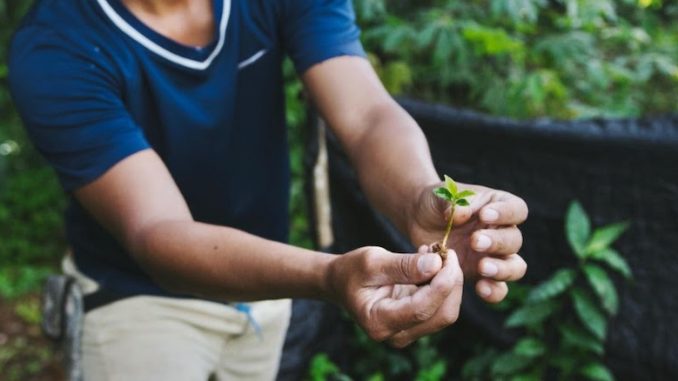
Agricultural organizations, including coffee-producing groups, take charge of nature-based climate solutions.
BY ALEXA ROMANO
SPECIAL TO BARISTA MAGAZINE ONLINE
Cover photo courtesy of Alexa Romano
Our recent first article in this series about carbon and coffee showed how the coffee industry contributes to carbon emissions through growing, transporting, and roasting coffee beans. Lately, many organizations are taking steps toward reducing their carbon footprint. This changes their classifications as carbon neutral, carbon net zero, carbon zero, or carbon negative.
Agricultural organizations, and even coffee producers themselves, are now taking initiatives to implement nature-based farming methods, while local organizations carry out carbon offsetting projects.
Carbon Sequestration Tools for Coffee Farmers
While many groups are pledging to reduce their carbon emissions and engage in the voluntary carbon market, others are building tools for coffee farmers and other agricultural producers to monitor the carbon footprint of their agricultural practices.
One such creation is the Cool Farm Tool, which measures on-farm greenhouse gas emissions and soil carbon sequestration. This tool is designed to get producers to think beyond minimizing negative carbon impacts by promoting agricultural systems that enhance ecosystems at their very roots. A recent article of ours reported that this tool is being piloted on organic coffee farms in Guatemala, Honduras, and Peru. It allows producers to manage their costs, productivity, and soil health. These measures stimulate thinking about how management decisions can sequester carbon or reduce greenhouse emissions, and aid producers to develop action plans.
Another coffee-specific resource is the FARM-TRACE tool, which is used to measure and verify forest impact and carbon sequestration across thousands of coffee farms at the same time. With this tool, Arvid Nordquist, a 100% climate-compensated coffee company, is collaborating with Rainforest Alliance to test a new and innovative method aiming to greatly reduce the carbon footprint of coffee production.
FARM-TRACE combines mobile app data and satellite imagery to help smallholder coffee producers create new forms of income from growing trees. FARM-TRACE also calculates smallholder coffee carbon emissions in a transparent way so that partner coffee brands can meet their pledged climate commitments. The main idea is that while smallholder coffee producers are affected by climate change, their actions combating climate change can also play an important role in reducing carbon emissions.

Nature-Based Solutions
Arguably at the corporate level, purchasing carbon offsets should not be used as the first option to get carbon emissions reductions. However, companies that do seek to finance carbon reduction projects are advised to invest in nature-based solutions, which cultivate and protect natural ecosystems. For example, an article discussing successful nature-based voluntary carbon offsetting emphasizes that corporations should first minimize their own operations before they buy carbon offsets; however, the most sustainable action to take is avoiding generating emissions in the first place, or preserving the environment (this includes avoiding deforestation or habitat loss).
A similar action would be to engage in projects that sequester carbon (this includes tree-planting projects and forest regeneration). Organizations that sequester carbon through these nature-based solutions would be classified as carbon negative.
Market-Based Conservation Models
Organizations try nature-based solutions through the voluntary carbon market. There are many organizations dedicated to climate change through carbon sequestration and local community engagement. They leverage the marketplace, or rather the voluntary carbon market, to create carbon credits while simultaneously implementing conservation projects that meet a Verified Carbon Standard (VCS).
The VCS program is the world’s most widely used voluntary greenhouse gas program. Nearly 1,700 certified VCS projects combined have reduced or removed more than 630 million tonnes of carbon emissions from the atmosphere. Under the VCS are different certifications that an organization can be eligible for depending on the goals of the project. These certifications usually represent community and biodiversity benefits achieved by projects, in addition to the climate benefits inherent in a VCS. A few of these sub-certifications and their descriptions include:
- Climate, Community & Biodiversity (CCB) Standards
- Sustainable Development Verified Impact Standard (SD VISta)
- W+ Standard
Another initiative is REDD+ (Reducing Emissions from Deforestation and Degradation), a climate change mitigation strategy that the United Nations started to help stop the destruction of the world’s forests. Using the carbon market, verified and purchased carbon offsets support REDD+ projects and bring direct benefits to communities. Verification is issued on an annual basis by third party verifiers only after a forest has been successfully protected and sustainable economic alternatives, such as job creation initiatives and agricultural intensification programs, have been created for the community.

Our Gorongosa Coffee
There are many agricultural organizations involved in the carbon marketplace, but one coffee-specific organization committed to environmental protection and carbon sequestration is Our Gorongosa coffee. One-hundred percent of Our Gorongosa’s coffee is reinvested back into Mozambique’s Gorongosa National Park (GNP). GNP is currently pursuing Verra VCS, CCB, and SD Vista certification for their coffee reforestation efforts, thus aiming to be another Verified Carbon Standard national park. They focus on environmental conservation and people-centered development through coffee production.
Each Our Gorongosa purchase is directed to three carbon and community initiatives: rainforest reforestation, girls’ education, and wildlife conservation. Eric Wilburn, Gorongosa National Park’s carbon project manager, shares that “Our Gorongosa’s sister organization, the Sustainable Development Department of Gorongosa National Park, identifies areas of Mount Gorongosa’s rainforests that were previously deforested, and employs local people to grow coffee in the shade of native rainforest saplings to simultaneously restore the rainforest, sequester carbon, and create local livelihoods.” Our Gorongosa believes that job creation and supporting local livelihoods is the key to ensuring communities can effectively protect forests and wildlife for the long term.
The final article of this series will continue to explore how economic profitability, social well-being, and increased livelihood opportunities advance environmental sustainability.

Alexa Romano (she/her) is a recent graduate from Stanford University with an MA and BA in Cultural and Social Anthropology with a double minor in Ethics in Society and Photography. Her research investigates the coffee commodity chain and looks at the mystified, obscured, and ethical/ unethical relations that tether producer societies to consumer societies with a particular focus on Costa Rican smallholder producers. In addition to freelance writing, Alexa is an HIIT instructor with a wellness tech company. Currently, she is learning barista skills at Ritual Coffee in San Francisco. See Alexa’s work here.

